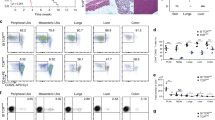Abstract
ALMOST 30 years ago Burnet proposed that the immune system maintained self-tolerance by deleting autoreactive lymphocytes1. Recently it has become clear that for T cells this step occurs in the thymus, where developing T cells first express their antigen-specific receptors2–4. Here a T-cell which encounters its antigen disappears—if it is not dead, it at least stops expressing its receptors. In the periphery by contrast, encounter with antigen leads to activation and proliferation of the responding T-cell. There are two possible explanations for this difference. Either the antigen-presenting cells in the thymus are different from those in the periphery and instead of producing positive signals they directly or indirectly kill the thymocytes5,6; or the T cells themselves are different, and like immature B cells, may die after encounter with antigen7,8. We tested the first possibility and found that dendritic cells from spleen, which are the most potent activators of mature T cells9, are also the most potent inactivators of young developing T cells. Thus it is not the antigen-presenting cell which determines whether a T-cell responds or dies, but the T-cell itself or its thymic environment.
This is a preview of subscription content, access via your institution
Access options
Subscribe to this journal
Receive 51 print issues and online access
$199.00 per year
only $3.90 per issue
Buy this article
- Purchase on Springer Link
- Instant access to full article PDF
Prices may be subject to local taxes which are calculated during checkout
Similar content being viewed by others
References
Burnet, F. M. The Clonal Selection of Acquired Immunity (Cambridge University Press, New York, 1959).
Kappler, J. W. et al. Nature 332, 35–40 (1988).
MacDonald, H. R. et al. Nature 332, 40–45 (1988).
Kisielow, P. et al. Nature 333, 742–746 (1988).
Miller, R. G. Nature 287, 544–546 (1980).
Rammensee, H.-G., Bevan M. J. & Fink, P. J. Immun. Today 6, 41–43 (1985).
Nossal, G. J. V. & Pike, B. J. exp. Med. 141, 904–917 (1975).
Metcalf, E. S. & Klinman, N. R. J. exp. Med. 143, 1327–1340 (1976).
Steinman, R. M. & Witmer, M. D. Proc. natn. Acad. Sci. U.S.A. 75, 5132–5136 (1978).
Robinson, J. H. & Owen, J. J. T. Clin. exp. Immun. 27, 322–327 (1977).
Robinson, J. H. & Owen, J. J. T. Nature 271, 758–760 (1978).
Ceredig, R. et al. J. exp. Med. 158, 1654–1671 (1983).
Snodgrass, R. et al. Nature 315, 232–233 (1985).
Kisielow, P., Leiserson, W. & von Boehmer, H. J. Immun. 133, 1117–1123 (1984).
Jenkinson, E. J., Jhittay, P., Kingston, R. & Owen, J. J. T. Transplantation 39, 331–333 (1985).
Shimonkevitz, R. P. & Bevan, M. J. J. exp. Med. 168, 143–156 (1988).
Bosma, C. G., Custer, R. P. & Bosma, M. J. Nature 301, 527–528 (1983).
Barclay, N. & Maryhoffer, G. J. exp. Med. 153, 1666–1671 (1981).
Minz, B. & Baker, W. W. Proc. natn. Acad. Sci. U.S.A. 58, 592–598 (1967).
Boyse, E. A. et al. Nature 227, 901–903 (1970).
Longo, D. L. & Schwartz, R. H. Nature 287, 44–46 (1980).
Kruisebeek, A. M. et al. J. exp. Med. 160, 839–857 (1984).
Hunig, T. & Bevan, M. J. Expl Cell Biol. 52, 7–11 (1984).
Groves, E. & Singer, A. J. J. exp. Med. 158, 1483–1497 (1983).
Matzinger, P., Zamoyska, R. & Waldmann, H. Nature 308, 738–741 (1984).
Matzinger, P. & Waterfield, J. D. Nature 285, 492–494 (1980).
von Boehmer, H. & Hafen, K. Nature 320, 626–628 (1986).
Bretscher, P. & Cohn, M. Science 169, 1042–1049 (1970).
Longo, D. L. & Schwartz, R. H. Nature 287, 44–46 (1980).
Fink, P. J., Bevan, M. J. & Weissman, I. L. J. exp. Med. 159, 36–41 (1984).
Malkovsky, M. & Medawar, P. B. Immun. Today 5, 340–343 (1984).
Zamoyska, R., Waldmann, H. & Matzinger, P. Eur. J. Immun. (in the press).
Author information
Authors and Affiliations
Rights and permissions
About this article
Cite this article
Matzinger, P., Guerder, S. Does T-cell tolerance require a dedicated antigen-presenting cell?. Nature 338, 74–76 (1989). https://doi.org/10.1038/338074a0
Received:
Accepted:
Issue Date:
DOI: https://doi.org/10.1038/338074a0
This article is cited by
-
CD83: an update on functions and prospects of the maturation marker of dendritic cells
Archives of Dermatological Research (2007)
-
Clonal deletion of thymocytes by circulating dendritic cells homing to the thymus
Nature Immunology (2006)
-
New strategies in immune tolerance induction
Cell Biochemistry and Biophysics (2004)
-
Negative selection — clearing out the bad apples from the T-cell repertoire
Nature Reviews Immunology (2003)
-
Mouse and human dendritic cell subtypes
Nature Reviews Immunology (2002)
Comments
By submitting a comment you agree to abide by our Terms and Community Guidelines. If you find something abusive or that does not comply with our terms or guidelines please flag it as inappropriate.



